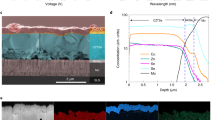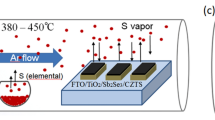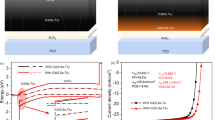Abstract
The conversion efficiency of kesterite solar cells has been stagnated at 12.6% since 2013. In contrast to chalcopyrite solar cells, the performance of kesterite solar cells is seriously limited by heterojunction interface recombination. Here we demonstrate kesterite/CdS heterojunction is constructed on a Zn-poor surface due to the dissolution of Zn2+ during chemical bath deposition. The occupation of Cd2+ on the Zn site and re-deposition of Zn2+ into CdS creates a defective and lattice-mismatched interface. Low-temperature annealing of the kesterite/CdS junction drives migration of Cd2+ from absorber back to CdS and Zn2+ from absorber bulk to surface, achieving a gradient composition and reconstructing an epitaxial interface. This greatly reduces interface recombination and improves device open-circuit voltage and fill factor. We achieve certified 12.96% efficiency small-area (0.11 cm2) and certified 11.7% efficiency large-area (1.1 cm2) kesterite devices. The findings are expected to advance the development of kesterite solar cells.
This is a preview of subscription content, access via your institution
Access options
Access Nature and 54 other Nature Portfolio journals
Get Nature+, our best-value online-access subscription
$29.99 / 30 days
cancel any time
Subscribe to this journal
Receive 12 digital issues and online access to articles
$119.00 per year
only $9.92 per issue
Buy this article
- Purchase on Springer Link
- Instant access to full article PDF
Prices may be subject to local taxes which are calculated during checkout





Similar content being viewed by others
Data availability
All data supporting the findings of this study are available within the paper and Supplementary Information files. Source data are provided with this paper.
References
Todorov, T. K. et al. Beyond 11% efficiency: characteristics of state-of-the-art Cu2ZnSn(S,Se)4 solar cells. Adv. Energy Mater. 3, 34–38 (2013).
Yan, C. et al. Cu2ZnSnS4 solar cells with over 10% power conversion efficiency enabled by heterojunction heat treatment. Nat. Energy 3, 764–772 (2018).
Giraldo, S. et al. Progress and perspectives of thin film kesterite photovoltaic technology: a critical review. Adv. Mater. 31, 1806692 (2019).
Xu, X. et al. Efficient and composition-tolerant kesterite Cu2ZnSn(S, Se)4 solar cells derived from an in situ formed multifunctional carbon framework. Adv. Energy Mater. 11, 2102298 (2021).
Fonoll-Rubio, R. et al. Insights into interface and bulk defects in a high efficiency kesterite-based device. Energy Environ. Sci. 14, 507–523 (2021).
Wang, W. et al. Device characteristics of CZTSSe thin-film solar cells with 12.6% efficiency. Adv. Energy Mater. 4, 1301465 (2014).
Son, D.-H. et al. Effect of solid-H2S gas reactions on CZTSSe thin film growth and photovoltaic properties of a 12.62% efficiency device. J. Mater. Chem. A 7, 25279–25289 (2019).
Nakamura, M. et al. Cd-free Cu(In,Ga)(Se,S)2 thin-film solar cell with record efficiency of 23.35%. IEEE J. Photovolt. 9, 1863–1867 (2019).
Shin, D. et al. Defect engineering in multinary Earth-abundant chalcogenide photovoltaic materials. Adv. Energy Mater. 7, 1602366 (2017).
Romanyuk, Y. E. et al. Doping and alloying of kesterites. J. Phys.: Energy 1, 044004 (2019).
Fu, J. et al. Ag, Ge dual-gradient substitution for low-energy loss and high-efficiency kesterite solar cells. J. Mater. Chem. A 8, 22292–22301 (2020).
Gong, Y. et al. Sn4+ precursor enables 12.4% efficient kesterite solar cell from DMSO solution with open circuit voltage deficit below 0.30 V. Sci. China Mater. 64, 52–60 (2021).
Gong, Y. et al. Identifying the origin of the Voc deficit of kesterite solar cells from the two grain growth mechanisms induced by Sn2+ and Sn4+ precursors in DMSO solution. Energy Environ. Sci. 14, 2369–2380 (2021).
Scragg, J. J. S. et al. A low-temperature order–disorder transition in Cu2ZnSnS4 thin films. Appl. Phys. Lett. 104, 041911 (2014).
Rey, G. et al. Ordering kesterite improves solar cells: a low temperature post-deposition annealing study. Sol. Energy Mater. Sol. Cells 151, 131–138 (2016).
Sardashti, K. et al. Impact of nanoscale elemental distribution in high-performance kesterite solar cells. Adv. Energy Mater. 5, 1402180 (2015).
Sardashti, K. et al. Nano-scale compositional analysis of surfaces and interfaces in Earth-abundant kesterite solar cells. J. Mater. Res. 31, 3473–3481 (2016).
Kim, S.-Y. et al. Effect of Cu–Sn–Se liquid phase on grain growth and efficiency of CZTSSe solar cells. Adv. Energy Mater. 10, 1903173 (2020).
Haight, R. et al. Electronic and elemental properties of the Cu2ZnSn(S,Se)4 surface and grain boundaries. Appl. Phys. Lett. 104, 033902 (2014).
Kim, J. et al. High efficiency Cu2ZnSn(S,Se)4 solar cells by applying a double In2S3/CdS emitter. Adv. Mater. 26, 7427–7431 (2014).
Su, Z. et al. Device postannealing enabling over 12% efficient solution-processed Cu2ZnSnS4 solar cells with Cd2+ substitution. Adv. Mater. 32, 2000121 (2020).
Nisika et al. Progress and prospects of CZTSSe/CdS interface engineering to combat high open-circuit voltage deficit of kesterite photovoltaics: a critical review. J. Mater. Chem. A 8, 21547–21584 (2020).
Lu, X. et al. Heterojunction post-heat treatment process driving high efficiency for Cu2ZnSnS4 solar cell. Sol. Energy Mater. Sol. Cells 230, 111204 (2021).
Koprek, A. et al. Cd and impurity redistribution at the CdS/CIGS interface after annealing of CIGS-based solar cells resolved by atom probe tomography. IEEE J. Photovolt. 7, 313–321 (2017).
Gong, Y. et al. Ag incorporation with controlled grain growth enables 12.5% efficient kesterite solar cell with open circuit voltage reached 64.2% Shockley–Queisser limit. Adv. Funct. Mater. 31, 2101927 (2021).
Wang, S. et al. Defects and surface electrical property transformation induced by elemental interdiffusion at the p–n heterojunction via high-temperature annealing. ACS Appl. Mater. Interfaces 13, 12211–12220 (2021).
Green, M. A. et al. Solar cell efficiency tables (version 59). Prog. Photovoltaics Res. Appl. 30, 3–12 (2022).
Li, Y. et al. Exploiting electrical transients to quantify charge loss in solar cells. Joule 4, 472–489 (2020).
Yu, S. et al. Solution-processed chalcopyrite solar cells: the grain growth mechanism and the effects of Cu/In mole ratio. Adv. Energy Mater. 12, 2103644 (2022).
Nakada, T. & Kunioka, A. Direct evidence of Cd diffusion into Cu(In, Ga)Se2 thin films during chemical-bath deposition process of CdS films. Appl. Phys. Lett. 74, 2444–2446 (1999).
El Hajraoui, K. et al. Atomic-scale interface modification improves the performance of Cu(In1–xGax)Se2/Zn(O,S) heterojunction solar cells. ACS Appl. Mater. Interfaces 13, 44207–44213 (2021).
Bar, M. et al. Zn–Se–Cd–S interlayer formation at the CdS/Cu2ZnSnSe4 thin-film solar cell interface. ACS Energy Lett. 2, 1632–1640 (2017).
Ennaoui, A. et al. Chemical-bath ZnO buffer layer for CuInS2 thin-film solar cells. Sol. Energy Mater. Sol. Cells 54, 277–286 (1998).
Lee, Y. S. et al. Cu2ZnSnSe4 thin-film solar cells by thermal co-evaporation with 11.6% efficiency and improved minority carrier diffusion length. Adv. Energy Mater. 5, 1401372 (2015).
Zhang, C. et al. A simple and efficient solar cell parameter extraction method from a single current-voltage curve. J. Appl. Phys. 110, 064504 (2011).
Shi, J. et al. Opto-electro-modulated transient photovoltage and photocurrent system for investigation of charge transport and recombination in solar cells. Rev. Sci. Instrum. 87, 123107 (2016).
Acknowledgements
H.X. and W.Y. acknowledge the funding from the National Key Research and Development Program of China (grant number 2019YFE0118100) and the National Natural Science Foundation of China (grant number 22075150). Q.M. acknowledges funding from the National Natural Science Foundation of China (number U2002216 and number 51972332). S.C. acknowledges funding from the National Natural Science Foundation of China (grant number 12174060) and the Shanghai Academic/Technology Research Leader (grant number 19XD1421300). R.G. acknowledges the support from the Molecular Analysis Facility, a National Nanotechnology Coordinated Infrastructure site at the University of Washington, which is supported, in part, by the National Science Foundation (NNCI-1542101), the University of Washington, the Molecular Engineering & Sciences Institute, the Clean Energy Institute and the National Institutes of Health. We thank X. Sha and T. Qiu of Zeiss for preparing TEM lamellae by cryo-FIB and TEM characterization. We acknowledge D.S. Ginger for useful discussion and comments.
Author information
Authors and Affiliations
Contributions
H.X. conceived the idea. H.X. and Y.G. designed the project and co-wrote the manuscript. Y.G. and Q.Z. fabricated and characterized the devices; B.L. fabricated and characterized the CISSe solar cells; S.W. and S.C. performed first-principles calculations and analysis of interface structure and electronic structure. B.D. and L.L performed M-TPV, M-TPC and C–V-DLCP analysis; C.X. and Q.D. performed SEM measurement and discussed the TEM data; E.J. and R.G. performed GDOES measurements and analysed the data; Y.Z. provided important assistance in device fabrication. H.X. and W.Y. supervised the research at NJUPT; Q.M. supervised the research at CAS; S.C. supervised the research at Fudan University. All authors discussed and analysed the results.
Corresponding authors
Ethics declarations
Competing interests
The authors declare no competing interests.
Peer review
Peer review information
Nature Energy thanks Edgardo Saucedo and the other, anonymous, reviewer(s) for their contribution to the peer review of this work.
Additional information
Publisher’s note Springer Nature remains neutral with regard to jurisdictional claims in published maps and institutional affiliations.
Supplementary information
Supplementary Information
Supplementary Figs. 1–21, Notes 1–8 and Tables 1–7.
Source data
Source Data Fig. 1
Unprocessed J–V and EQE data, statistical device data, integrated JSC from EQE, derivative of EQE versus wavelength.
Source Data Fig. 2
Unprocessed TPV, TPC, Raman, C–V and DLCP data and temperature-dependent VOC data.
Source Data Fig. 3
Unprocessed EDX line scan profile data.
Source Data Fig. 4
Unprocessed XPS and J–V data, element content change with CBD time.
Source Data Fig. 5
Unprocessed J–V, EQE data and device stability data.
Rights and permissions
Springer Nature or its licensor holds exclusive rights to this article under a publishing agreement with the author(s) or other rightsholder(s); author self-archiving of the accepted manuscript version of this article is solely governed by the terms of such publishing agreement and applicable law.
About this article
Cite this article
Gong, Y., Zhu, Q., Li, B. et al. Elemental de-mixing-induced epitaxial kesterite/CdS interface enabling 13%-efficiency kesterite solar cells. Nat Energy 7, 966–977 (2022). https://doi.org/10.1038/s41560-022-01132-4
Received:
Accepted:
Published:
Issue Date:
DOI: https://doi.org/10.1038/s41560-022-01132-4
This article is cited by
-
Comparative study on the effects of substitutional Ag and substitutional Ge on kesterite thin-film solar cells
Applied Physics A (2024)
-
Flexible Cu2ZnSn(S,Se)4 thin film solar cells with lithium doping via doctor blading
Science China Materials (2024)
-
Single-phase evolution path to new record efficiency of kesterite solar cells
Science China Chemistry (2024)
-
Effect of back contact surface nitriding on the growth of Cu2ZnSnSe4 and solar cells performances
Journal of Materials Science: Materials in Electronics (2024)
-
Engineered interfaces for heterostructured intermetallic nanomaterials
Nature Synthesis (2023)



